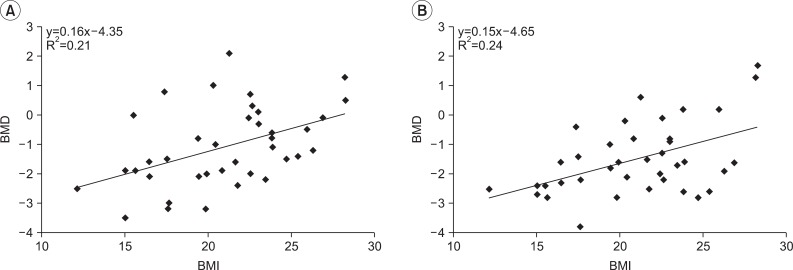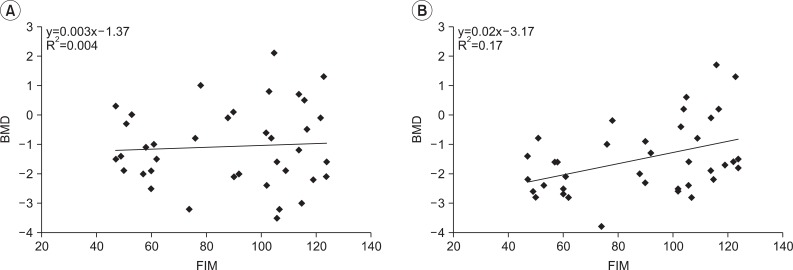Ann Rehabil Med.
2012 Dec;36(6):770-775.
Factors Affecting Bone Mineral Density in Adults with Cerebral Palsy
- Affiliations
-
- 1Department and Research Institute of Rehabilitation Medicine, Yonsei University College of Medicine, Seoul 120-752, Korea. srcho918@yuhs.ac
Abstract
OBJECTIVE
To clarify factors affecting bone mineral density (BMD) in adults with cerebral palsy (CP). METHOD: Thirty-five patients with CP participated in this study. Demographic data including gender, age, body mass index (BMI), subtype according to neuromotor type and topographical distribution, ambulatory function, and functional independence measure (FIM) were investigated. The BMD of the lumbar spine and femur were measured using Dual-energy X-ray absorptiometry, and the factors affecting BMD were analyzed.
RESULTS
The BMD had no significant association with factors such as gender, age, and subtype in adults with CP. However, BMI was significantly correlated with the BMD of lumbar spine and femur (p<0.05). The FIM score was also positively correlated with the BMD of femur (p<0.05). Moreover, CP patients with higher ambulatory function had significantly higher BMD of femur (p<0.05).
CONCLUSION
These findings suggest that BMI and functional levels such as FIM and ambulatory function can affect BMD in adults with CP. The results might be used as basic data, suggesting the importance of treatment including weight bearing exercise and gait training in adults with CP.
MeSH Terms
Figure
Reference
-
1. Garnero P, Delmas PD. New developments in biochemical markers for osteoporosis. Calcif Tissue Int. 1996; 59(Suppl 1):S2–S9. PMID: 8974724.
Article2. Gelfand IM, DiMeglio LA. Bone mineral accrual and low bone mass: a pediatric perspective. Rev Endocr Metab Disord. 2005; 6:281–289. PMID: 16311946.
Article3. Bachrach LK. Acquisition of optimal bone mass in childhood and adolescence. Trends Endocrinol Metab. 2001; 12:22–28. PMID: 11137037.
Article4. Henderson RC, Kairalla J, Abbas A, Stevenson RD. Predicting low bone density in children and young adults with quadriplegic cerebral palsy. Dev Med Child Neurol. 2004; 46:416–419. PMID: 15174534.
Article5. Henderson RC, Kairalla JA, Barrington JW, Abbas A, Stevenson RD. Longitudinal changes in bone density in children and adolescents with moderate to severe cerebral palsy. J Pediatr. 2005; 146:769–775. PMID: 15973316.
Article6. Schoenau E, Frost HM. The "muscle-bone unit" in children and adolescents. Calcif Tissue Int. 2002; 70:405–407. PMID: 11960207.
Article7. King W, Levin R, Schmidt R, Oestreich A, Heubi JE. Prevalence of reduced bone mass in children and adults with spastic quadriplegia. Dev Med Child Neurol. 2003; 45:12–16. PMID: 12549750.
Article8. Ottenbacher KJ, Hsu Y, Granger CV, Fiedler RC. The reliability of the functional independence measure: a quantitative review. Arch Phys Med Rehabil. 1996; 77:1226–1232. PMID: 8976303.
Article9. Bae BW, Lee DS, Seo YJ, Baek JH, Kim ES, Park HS, Cho SR. Comparison of energy expenditure and walking performance by arm cycling and leg cycling exercise. J Korean Acad Rehabil Med. 2009; 33:584–590.10. Sheridan KJ. Osteoporosis in adults with cerebral palsy. Dev Med Child Neurol. 2009; 51(Suppl 4):38–51. PMID: 19740209.
Article11. Moon JL, Lim JE, Moon YW, Song DH. Hip subluxation according to neuromotor type and motor quotient in patients with cerebral palsy. J Korean Acad Rehabil Med. 2004; 28:126–131.12. Choi SH, Park IJ, Joo NS, Kim BT. Reference value for the T-score in osteoporosis diagnosis by health screening subjects. Korean J Bone Metab. 2008; 15:67–76.13. De Laet C, Kanis JA, Odén A, Johanson H, Johnell O, Delmas P, Eisman JA, Kroger H, Fujiwara S, Garnero P, et al. Body mass index as a predictor of fracture risk: a meta-analysis. Osteoporos Int. 2005; 16:1330–1338. PMID: 15928804.
Article14. Houlihan CM, Stevenson RD. Bone density in cerebral palsy. Phys Med Rehabil Clin N Am. 2009; 20:493–508. PMID: 19643349.
Article15. Iwasaki T, Nonoda Y, Ishii M. Long-term outcomes of children and adolescents who had cerebral palsy with secondary osteoporosis. Curr Med Res Opin. 2012; 28:737–747. PMID: 22126423.
Article16. Coppola G, Fortunato D, Auricchio G, Mainolfi C, Operto FF, Signoriello G, Pascotto A, Salvatore M. Bone mineral density in children, adolescents, and young adults with epilepsy. Epilepsia. 2009; 50:2140–2146. PMID: 19486359.
Article17. Brunner R, Doderlein L. Pathologic fractures in patients with cerebral palsy. J Pediatr Orthop B. 1996; 5:232–238. PMID: 8897254.
- Full Text Links
- Actions
-
Cited
- CITED
-
- Close
- Share
- Similar articles
-
- Bone Mineral Density and Biochemical Markers of Bone Turnover in Cerebral Palsy Patients According to Severity and Type
- Bone Mineral Density and Bone Markers in the Children with Epilepsy Taking on Chronic Anticonvulsants
- Bone health in pediatric patients with neurological disorders
- The relationship of maturation value of vaginal epithelium and bone mineral density in postmenopausal women
- Measurement of bone mineral density in Korean newborns by dual photon absorptiometry



